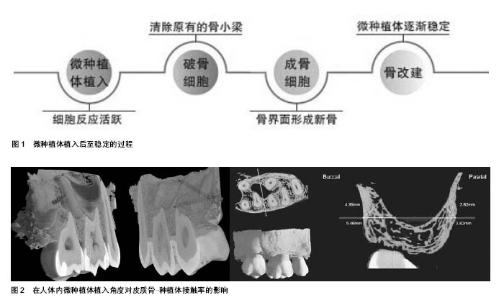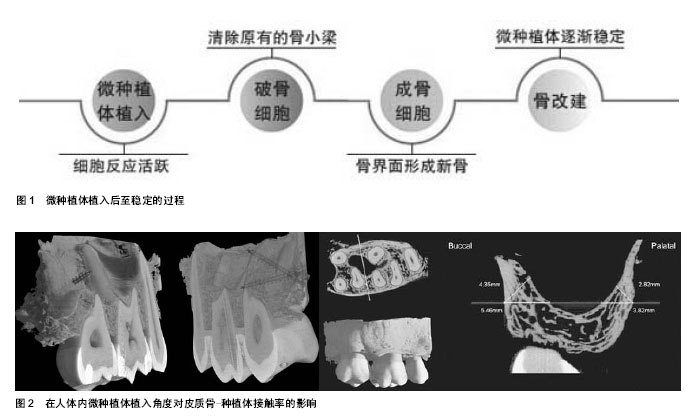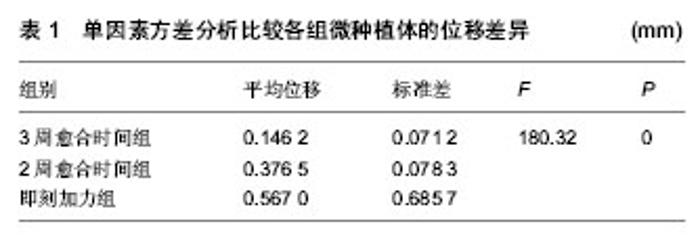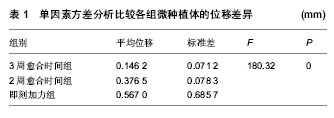Chinese Journal of Tissue Engineering Research ›› 2015, Vol. 19 ›› Issue (8): 1295-1300.doi: 10.3969/j.issn.2095-4344.2015.08.027
Previous Articles Next Articles
Factors affecting the stability of mini-implants
Lin Yang-dong1, Wu Ye-ke2
- 1Department of Stomatology, Tianjin First Central Hospital, Tianjin 300192, China; 2Department of Stomatology, Affiliated Hospital of Chengdu University of TCM, Chengdu 610075, Sichuan Province, China
-
Revised:2015-02-01Online:2015-02-19Published:2015-02-19 -
About author:Lin Yang-dong, Master, Associate chief physician, Department of Stomatology, Tianjin First Central Hospital, Tianjin 300192, China
CLC Number:
Cite this article
Lin Yang-dong, Wu Ye-ke. Factors affecting the stability of mini-implants [J]. Chinese Journal of Tissue Engineering Research, 2015, 19(8): 1295-1300.
share this article

2.1 植入区域皮质骨厚度 临床经验表明,种植体植入区的骨质和骨量对于其初始稳定性及长期成功率影响颇大,但目前关于骨质和骨量对于牙科种植体初始稳定性及长期成功率的影响目前仍存在争议。有研究证明较厚的皮质骨与较高的微种植体成功率相关,并建议临床上皮质骨厚度至少达到1 mm[7]。据此理论,具有较大皮质骨厚度的下颌骨微种植体成功率应高于上颌骨,也得到一些实验的支持。同时,Xu等[8]的动物实验表明,相对较大的皮质骨厚度利于初期稳定性的获得,而较薄的皮质骨更有益于长期稳定性的逐渐积累。另外,研究者们通过研究各解剖区域的皮质骨厚度,试图为临床上微种植体的最佳植入位置提供参考。Lim等[9]指出上下颌骨前部的皮质骨厚度并无显著差异,但后部相差明显,上颌尖牙根间区的近中和远中皮质骨最厚,下颌骨皮质骨从前向后逐渐增厚,且最厚处位于牙槽嵴下4 mm处。Silve strini Biavati等[10]通过计算机断层扫描对上下颌骨进行分析,得出颊舌侧平均皮质骨厚度在上颌骨分别为1.1 mm和1.27 mm,在下颌骨为2.23 mm和2.02 mm,且牙槽骨骨量最大的部位是上颌第二前磨牙与第一磨牙之间的腭侧。第二双尖牙与第一磨牙、第一二磨牙之间颊腭向拥有类似的较高厚度。Farnsworth等[11]认为下颌骨后部皮质骨厚度大于前部,上颌第一二前磨牙、第二前磨牙-第一磨牙根间区骨质比外侧切牙-尖牙、第一二磨牙要大,腭骨前部中线附近比后部的皮质骨更厚。Marquezan等[12]发现硬腭的皮质骨厚度从前部到后部逐渐降低,从腭中缝附近到其两侧3 mm和6 mm处先增加后减少,但各部位的平均皮质骨厚度均在1 mm的安全阈值以上,结合考虑被覆黏膜厚度,建议微种植体的最适切牙孔后4 mm,腭中缝附近3 mm范围内。目前正畸临床上对临时支抗装置施加的各种力值仍可在治疗的各个阶段放心使用。 2.2 植入区域是否邻近拔牙创 拔牙是正畸治疗的常用手段,有报道部分拔牙区附近植入的种植体出现松脱现象,因此拔牙创对微种植体骨整合和稳定性的影响引发人们关注。拔牙区创伤的愈合与牙槽骨重建是一动态过程,拔牙后1周可见大量炎性细胞聚集,牙槽骨吸收,第3周有新生皮质骨出现,8周后变为成熟的层状骨,拔牙区微种植体植入也是一种创伤,其愈合过程与上述情况类似。拔牙创愈合早期常见牙槽骨的萎缩,导致附近骨密度降低,Miyawaki等[13]证明较低的骨密度是种植体-骨界面整合的高危因素,Zheng等[14]的研究亦表明植入后 1周,拔牙创附近微种植体的最大拉拔力值和骨-种植体结合率均显著低于非拔牙创组,松脱风险明显增加,而植入后3周是骨重建的活跃期,提示植入后3周再进行力学加载。 2.3 植入方式 微种植体植入方式可分为助攻型、自攻型和非攻入型。相较自攻型微种植体,助攻型植入时若钻孔直径过大,易导致种植体植入后松动,钻速控制不当时亦会损伤邻近骨质;而非攻入型微种植体有螺丝锥样的尖部,并具备特制的切割槽使其植入时不需钻孔,因而产生较少的骨碎屑和热损伤,研究表明能导致更密切的种植体-骨接触和更有效的骨整合,有利于降低早期正畸力学加载中为微种植体的脱落率[15-16]。 钛金属作为一种重要的生物材料,在最近的几十年中已被广泛应用于牙种植体技术中,而决定种植体成功率的关键因素就是钛金属表面的性能。目前,有许多学者们研究了好多种可以对钛金属种植体表面进行改性的新技术,用来提高种植体的骨结合成功率,如:喷砂和酸蚀的改性技术是最常用的,它也成为种植体骨结合的一种重要特性;此外,还有一些表面改性技术,例如改变种植体表面的弹性模量,试探性的改变其表面生物活性;近期材料专家们关注的另一热点是将各种蛋白质类的活性物质附着在种植体表面后的作用。然而在临床上当钛种植体刚植入骨内时,首先会被血液包围,血液中的各种蛋白质也会对其形成良好的骨性愈合发挥极其重要的作用。综上所述,种植体表面的改性能够提高种植体骨结合结合率。这些研究为临床上选择种植体方式的成功率提供了很大帮助。 2.4 植入角度 大量研究表明轻度倾斜植入的微种植体比垂直植入者能获得更好的种植体-骨接触、骨整合及初期稳定性,避免牙根损伤[17-18]。Laursen等[19]报道在人体微种植体植入角度由90°变为45°能增加47%的皮质骨-种植体接触率,因而增加了微种植体的稳定性(图2)。在犬的下颌骨,建议将微种植体以与骨面小于90°的角度植入,可降低触及牙根的可能性[20]。最近,Xu等[21]在比格犬的下颌第一磨牙和第三前磨牙根间区以30°、50°、70°和90°植入微种植体,即刻进行2 N的力学加载,持续8周,行显微CT扫描和力学拉拔试验测试,表明50°-70°最有利于稳定性的获得,过于垂直和倾斜都应予以避免。 2.5 加载时程 除了持续力,间断力亦常规应用于正畸临床治疗,如用于前牵引上颌骨的面弓式矫治器、腭部扩弓器以及螺旋弹簧、橡皮圈、弹性橡皮链等产生随时间迅速衰减力的正畸装置。临床经验和研究表明在相同力值大小情况下,持续时间更长的力较瞬时力能产生更大的作用(牙移动、中缝扩展、骨改建等)[22-23]。相反,也有研究提示力学加载过程中长达数秒至数周的间歇期和恢复期能显著增强骨改建,招募更多的破骨细胞[24]。有报道表明在弹簧每1,2,3周的重新加力周期内引入3 d的间歇期能比持续加载带来更少的根吸收[25]。随着对更高临床矫治效率和更短恢复时间的迫切需求,人们提出了微种植体的即刻和持续加载,然而该方式产生的早期微动不仅能导致根吸收,也降低了骨整合;相反,低强度的延迟加载能显著降低微动的产生,不影响种植体周矿化骨质的形成[26]。类似地,间断力加载下的微种植体也可能由于应力持续时间较短,在骨-种植体界面产生微动和折裂较少,在后期获得较高的稳定性。Wu等[27]最近的动物实验表明在每2周的重新加力周期末期引入 3 d或7 d的间歇期,能显著增加微种植体的骨整合和稳定性。 2.6 植入、去除力矩 微种植体作为骨内绝对直抗能抵抗较强的正畸力,在治疗结束后随即取出。但过大力值及不良转矩也对微种植体的稳定性和成功率构成一定威胁。Liou等[28]的试验中纳入16例患者,以微种植体为支抗整体内收上前牙,植入后2周加力,加力前和9个月后分别行头影测量分析,结果发现种植体头部发生了平均0.4 mm的前倾移位,其中7例受试者发生了1.0-1.5 mm的伸长和前倾移位。因此建议微种植体应尽量选择无牙区及不涉及裂孔、重要神经、血管的区域,或者与牙根至少有2 mm安全距离的部位。Cho等[29]的研究认为转矩的方向和大小均对加载下的微种植体稳定性有影响,其中逆时针方向的转矩影响较大。Suzuki 等[30]报道在所有植入区自攻型微种植体的最大植入力矩(14.5 N•cm)显著大于助攻型(9.2 N•cm),其中腭中缝及上下颌牙槽骨区域植入力矩值最高;相反,助攻型的最大去除力矩(22.6 N•cm)高于自攻型(17.6 N•cm),结果提示最大植入和去除力矩成相反关系,较小的植入力矩有利于骨整合。Chen等[31]发现微种植体平均去除力矩值为10.8 N•cm,其中约半数大于8.7 N•cm。下颌骨显著高于上颌骨,长度为15 mm和17 mm的微种植体力矩值明显高于13 mm,表明力矩值的大小与植入部位及种植体长度密切相关,而与年龄、性别、愈合期、发挥功能时间等没有显著关联。当微种植体被作为支抗用来竖直倾斜磨牙时,逆时针方向过大的力矩可能使其松脱,而当去除力矩值大于8.7 N•cm时则足以使其作为支抗在三维方向上移动牙齿。Motoyoshi等[32]发现上、下颌间植入转矩值有显著差异,失败组转矩值远高于成功组,因此过大的植入转矩应禁止使用,并建议为提高直径1.6 mm微种植体的成功率,力矩值应控制在 5-10 N•cm。 2.7 植入后愈合时间 临床上实施正确的支抗设计和良好的支抗控制是决定正畸治疗能否成功的至关重要因素。但传统的支抗控制方法中难以提供绝对稳定的支抗,而支抗不足是影响正畸治疗效果的关键因素。微种植体支抗作为一种稳定有效且不依赖于患者合作的新支抗手段逐渐受到人们的重视。目前有关微种植支抗的动物实验和临床实践虽然均取得了较为满意的效果,但有时也会出现像需要“绝对支抗”的病例微种植体种植失败的例子,而最终不得不改变使用其他支抗方式,也就给正畸医师带来了很大困扰。对于微种植体种植失败的具体原因是什么,目前依然还没有完全认清,现有的研究认为影响微种植体稳定性的因素有很多,其中愈合时间被认为是最重要的影响因素之一。许多研究致力于决定正畸加力前必须的愈合时间,但结论未得到完全一致。究其根本原因有两种:其一是影响微种植体稳定性的多种因素互相制约,二是对愈合时间影响种植体稳定性的具体过程认识还不够深入。 为了更好地节省患者和医生的时间,缩短正畸疗程,目前临床上倾向于植入后即刻或更早地对微种植体施加应力。然而根据微动理论,微种植体早期由于应力加载产生的微动会阻碍种植体-骨界面的形成,其中应力区表现为软组织包裹而非骨愈合,对其初始稳定性(由机械锚合决定)造成不利影响,因此加力前应确保种植体已达到足够的骨整合和稳定性,即刻加力应慎重采用[33-34]。Zhao等[35]的研究表明3周是微种植体-骨愈合的关键时间点,植入后3周进行应力加载的微种植体稳定性显著高于即刻和1周组,而与5周、7周组差异较小,提示3周愈合期后应力加载造成的微动在可承受范围内,不会影响种植体周矿化组织形成。Deguchi等[36]也建议微种植体在作为坚强骨内支抗抵抗正畸外力前应至少有3周的愈合期。然而另一些研究表明种植体的加载时机对其骨-种植体接触和稳定性影响甚小,即刻加载和延期加载的种植体成功率无明显差异[37-39]。关于种植体究竟该何时加载,目前尚存争议,目前临床上微种植体通常采用即刻加载或2周后加载的方式。有研究分析了植入后3周进行应力加载的表现,结果显示虽然2周、3周和即刻组的微种植体发生的位移在小范围内均有变化(表1),但是通过两两比较可以发现3周组种植体之间的位移还是有差别的。经过3周愈合时间的种植体移动距离最小,2周愈合时间的种植体次之,即刻加力的位移最大,这也就提示如果植入部位的安全距离足够且骨密质又比较好的患者,在施加正畸力不大的情况下是可以进行即刻加载的;反而言之如果植入的部位是比较狭窄的,骨密质情况又较差或年龄较小的患者,可以考虑延长愈合时间。实验表明了微种植体可作为有效的正畸增强支抗装置。即刻加力、2周愈合时间和3周愈合时间的种植体都不是绝对支抗,加力后种植体均发生了位移。不同愈合时间的种植体支抗强弱不相同,从微种植体发生的位移看,3周愈合时间种植体发生的位移最小,而即刻加载种植体发生的位移最大。同时,不同愈合时间,微种植体的位移值是有差别的,从一个侧面反映了不同愈合对导致种植体稳定性的差异。"

| [1] Leung MT,Lee TC,Rabie AB,et al.Use of miniscrews and miniplates in orthodontics . J Oral Maxillofac Surg.2008; 66(7):1461-1466.
[2] Carano A,Velo S,Leone P,et al.Clinical applications of the miniscrew anchorage system.J Clin Orthod.2005;39(1):9-24.
[3] Papageorgiou SN,Zogakis IP,Papadopoulos MA.Failure rates and associated risk factors of orthodontic miniscrew implants: a meta-analysis.Am J Orthod Dentofacial Orthop.2012;142(5): 577-595.e7.
[4] Schätzle M,Männchen R,Zwahlen M,et al.Survival and failure rates of orthodontic temporary anchorage devices: a systematic review. Clin Oral Implants Res.2009;20(12):1351-1359.
[5] Oltramari-Navarro PV,Navarro RL,Henriques JF,et al.The impact of healing time before loading on orthodontic mini-implant stability: A histomorphometric study in minipigs. Arch Oral Biol.2013;58(7):806-812.
[6] Janson G,Gigliotti MP,Estelita S,et al.Influence of miniscrew dental root proximity on its degree of late stability.Int J Oral Maxillofac Surg.2013;42(4):527-534.
[7] Motoyoshi M,Inaba M,Ono A,et al.The effect of cortical bone thickness on the stability of orthodontic miniimplants and on the stress distribution in surrounding bone.Int J Oral Maxillofac Surg.2009;38(1):13-18.
[8] Xu Z,Zhao L,Wu Y,et al.Histomorphometric and biomechanical analyses of the osseointegration of loaded orthodontic microscrews inserted at different cortical bone thickness sites.Oral Surg Oral Med Oral Pathol Oral Radiol. 2014;118(2):157-165.
[9] Lim JE,Lee SJ,Kim YJ,et al.Comparison of cortical bone thickness and root proximity at maxillary and mandibular interradicular sites for orthodontic mini-implant placement. Orthod Craniofac Res.2009;12(4):299-304.
[10] Silvestrini Biavati A,Tecco S,Migliorati M,et al. Three-dimensional tomographic mapping related to primary stability and structural miniscrew characteristics. Orthod Craniofac Res.2011;14(2):88-99.
[11] Farnsworth D,Rossouw PE,Ceen RF,et al.Cortical bone thickness at common miniscrew implant placement sites.Am J Orthod Dentofacial Orthop.2011;139(4):495-503.
[12] Marquezan M,Nojima LI,Freitas AO,et al.Tomographic mapping of the hard palate and overlying mucosa.Braz Oral Res.2012;26(1):36-42.
[13] Miyawaki S,Koyama I,Inoue M,et al.Factors associated with the stability of titanium screws placed in the posterior region for orthodontic anchorage.Am J Orthod Dentofacial Orthop. 2003;124(4):373-378.
[14] Zheng L,Tang T,Deng F,et al.The influence of extraction on the stability of implanted titanium microscrews: a biomechanical and histomorphometric study.Int J Oral Maxillofac Implants.2009;24(2):267-274.
[15] Florvaag B,Kneuertz P,Lazar F,et al.Biomechanical properties of orthodontic miniscrews. An in-vitro study.J Orofac Orthop. 2010;71(1):53-67.
[16] Heidemann W,Terheyden H,Gerlach KL.Analysis of the osseous/metal interface of drill free screws and self-tapping screws.J Craniomaxillofac Surg.2001;29(2): 69-74.
[17] Holm L,Cunningham SJ,Petrie A,et al.An in vitro study of factors affecting the primary stability of orthodontic mini-implants.Angle Orthod.2012;82(6):1022-1028.
[18] Inaba M.Evaluation of primary stability of inclined orthodontic mini-implants. J Oral Sci.2009;51(3):347-353.
[19] Laursen MG,Melsen B,Cattaneo PM.An evaluation of insertion sites for mini-implants: a micro - CT study of human autopsy material.Angle Orthod.2013;83(2):222-229.
[20] Salmória KK,Tanaka OM,Guariza-Filho O,et al.Insertional torque and axial pull-out strength of mini-implants in mandibles of dogs.Am J Orthod Dentofacial Orthop. 2008; 133(6):790.e15-22.
[21] Xu Z,Wu Y,Zhao L,et al.Effect of placement angle on the stability of loaded titanium microscrews in beagle jaws.Angle Orthod.2013;83(4):659-666.
[22] Deguchi T,Murakami T,Kuroda S,et al.Comparison of the intrusion effects on the maxillary incisors between implant anchorage and J-hook headgear.Am J Orthod Dentofacial Orthop.2008;133(5):654-660.
[23] Liu SS,Kyung HM,Buschang PH.Continuous forces are more effective than intermittent forces in expanding sutures.Eur J Orthod.2010;32(4):371-380.
[24] Kumasako-Haga T,Konoo T,Yamaguchi K,et al.Effect of 8-hour intermittent orthodontic force on osteoclasts and root resorption.Am J Orthod Dentofacial Orthop. 2009;135(3):278.
[25] Aras B,Cheng LL,Turk T,et al.Physical properties of root cementum: part 23. Effects of 2 or 3 weekly reactivated continuous or intermittent orthodontic forces on root resorption and tooth movement: a microcomputed tomography study.Am J Orthod Dentofacial Orthop.2012; 141(2):e29-e37.
[26] Kim SH,Choi BH,Li J,et al.Peri-implant bone reactions at delayed and immediately loaded implants: an experimental study.Oral Surg Oral Med Oral Pathol Oral Radiol Endod. 2008;105(2):144-148.
[27] Wu Y,Xu Z,Tan L,et al.Orthodontic Mini-Implant Stability under Continuous or Intermittent Loading: A Histomorphometric and Biomechanical Analysis.Clin Implant Dent Relat Res.2015; 17(1):163-172.
[28] Liou EJ,Pai BC,Lin JC.Do miniscrews remain stationary under orthodontic forces? Am J Orthod Dentofacial Orthop.2004; 126(1):42-47.
[29] Cho YM,Cha JY,Hwang CJ.The effect of rotation moment on the stability of immediately loaded orthodontic miniscrews: a pilot study.Eur J Orthod.2010;32(6): 614-619.
[30] Suzuki EY,Suzuki B.Placement and removal torque values of orthodontic miniscrew implants.Am J Orthod Dentofacial Orthop.2011;139(5):669-678.
[31] Chen YJ,Chen YH,Lin LD,et al.Removal torque of miniscrews used for orthodontic anchorage--a preliminary report.Int J Oral Maxillofac Implants.2006;21(2):283-289.
[32] Motoyoshi M,Hirabayashi M,Uemura M,et al.Recommended placement torque when tightening an orthodontic mini-implant.Clin Oral Implants Res.2006;17(1):109-114.
[33] Trisi P,Perfetti G,Baldoni E,et al.Implant micromotion is related to peak insertion torque and bone density.Clin Oral Implants Res.2009;20(5):467-471.
[34] Okazaki J,Komasa Y,Sakai D,et al.A torque removal study on the primary stability of orthodontic titanium screw mini-implants in the cortical bone of dog femurs. Int J Oral Maxillofac Surg.2008;37(7):647-450.
[35] Zhao L,Xu Z,Yang Z,et al.Orthodontic mini-implant stability in different healing times before loading: a microscopic computerized tomographic and biomechanical analysis.Oral Surg Oral Med Oral Pathol Oral Radiol Endod.2009;108(2): 196-202.
[36] Deguchi T,Takano-Yamamoto T,Kanomi R,et al.The use of small titanium screws for orthodontic anchorage.J Dent Res. 2003;82(5):377-381.
[37] Jung BA,Harzer W,Wehrbein H,et al.Immediate versus conventional loading of palatal implants in humans: a first report of a multicenter RCT. Clin Oral Investig 2011; 15(4): 495-502.
[38] Woods PW,Buschang PH,Owens SE,et al.The effect of force, timing, and location on bone-to-implant contact of miniscrew implants.Eur J Orthod.2009;31(3): 232-240.
[39] Jackson A,Lemke R,Hatch J,et al.A comparison of stability between delayed versus immediately loaded orthodontic palatal implants. J Esthet Restor Dent.2008;20(3): 174-184. |
| [1] | Fang Ming, Wang Zhi-ying, Yu Jin, Li Min, Jin Ding. Osteoprotegerin expression in the peri-implant sulcus fluid after mechanical stimulations at different angles [J]. Chinese Journal of Tissue Engineering Research, 2015, 19(8): 1255-1260. |
| [2] | Wang Fang-hui, Zhang Shan-shan, Shu Jing-yuan, Gao Yan, Sun Xiao-kun, Wang Qing-shan. Effects of surface modification of titanium implants on the osseointegration [J]. Chinese Journal of Tissue Engineering Research, 2014, 18(52): 8491-8497. |
| [3] | Cheng Si-yuan, Wen Hai-lin, Si Jing-qiu, Liang Rui, Nie Jing, Wang Hang, Long Jie, Tang Wei, Wei Yong-tao, Tian Wei-dong. Biomechanical evaluation and optimal design of two parameters of dental implant with arbitrarily adjusted angles [J]. Chinese Journal of Tissue Engineering Research, 2014, 18(34): 5473-5479. |
| [4] | Li Jia-feng, Cui Qun, Sun Xiu-ying, Xu Lei, Sun Jin-hu, Han Jian-guo. Nano-hydroxyapatite/polycaprolactone electrospinning scaffolds repair bone defects around the immediate implant [J]. Chinese Journal of Tissue Engineering Research, 2014, 18(16): 2557-2562. |
| [5] | Yang Ying, Zhong Wei-jian, Liu Guo, Ma Guo-wu. Autologous bone marrow aspirate concentrate repairs peri-implant bone defect [J]. Chinese Journal of Tissue Engineering Research, 2014, 18(11): 1653-1658. |
| Viewed | ||||||
|
Full text |
|
|||||
|
Abstract |
|
|||||

